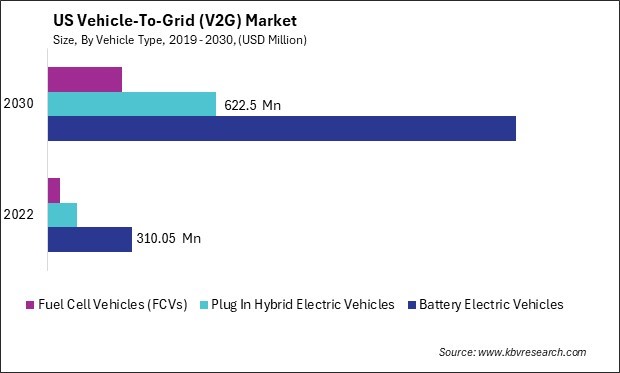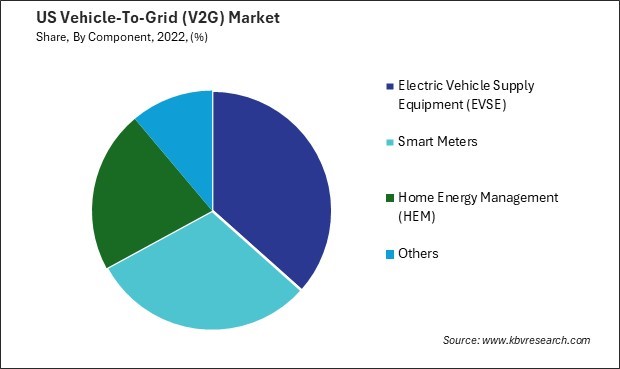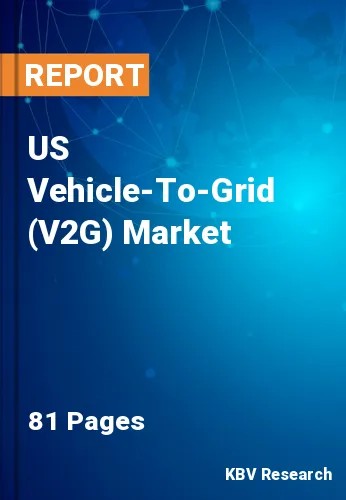The United States (US) Vehicle-To-Grid (V2G) Market size is expected to reach $2.6 Billion by 2030, rising at a market growth of 23.9% CAGR during the forecast period.
The vehicle-to-grid (V2G) market in the United States is experiencing significant growth and innovation as the country transitions towards a more sustainable and resilient energy ecosystem. One of the driving factors behind the expansion of the vehicle-to-grid (V2G) market in the U.S. is the increasing adoption of electric vehicles. With a growing awareness of environmental issues and government initiatives promoting clean energy transportation, the EV industry in the U.S. has witnessed substantial growth. As more electric vehicles hit the U.S. roads, the potential for leveraging their batteries as grid assets through V2G technology becomes more significant.

In the United States, utilities are actively exploring and implementing V2G projects to enhance grid stability and manage the intermittency of renewable energy sources. These projects involve partnerships between utilities, automakers, and technology providers to develop V2G infrastructure and integrate it into the existing electric grid. By utilizing the energy stored in EV batteries during periods of low demand and feeding it back during peak hours, V2G helps balance the grid. It reduces the need for additional fossil fuel-based power generation.
However, the vehicle-to-grid (V2G) market in the U.S. has yet to be immune to the impacts of the COVID-19 pandemic. The pandemic led to disruptions in supply chains, delayed infrastructure projects, and economic uncertainties, affecting the overall growth trajectory of the vehicle-to-grid (V2G) market. Lockdowns and restrictions hindered the production and deployment of electric vehicles and charging infrastructure, slowing the adoption of V2G technology.
Despite the short-term setbacks caused by the pandemic, the long-term outlook for the U.S. vehicle-to-grid (V2G) market remains optimistic. As the world recovers from the effects of COVID-19, there is a renewed focus on sustainable and resilient solutions, making V2G technology a key component of future energy strategies. Government stimulus packages aimed at economic recovery also include provisions to support the development of V2G infrastructure, further accelerating its growth in the post-pandemic era.
The automotive industry in the United States is experiencing a transformative shift with the integration of vehicle-to-grid (V2G) technology, marking a significant leap toward a sustainable and interconnected energy ecosystem. One key driver of the expansion of V2G in the U.S. is the increasing adoption of electric vehicles (EVs). With the automotive landscape witnessing a paradigm shift towards electrification, EVs are becoming more prevalent on American roads. This surge in electric vehicle ownership has created a suitable environment for V2G integration, as these vehicles can act as mobile energy storage units, feeding excess power back into the grid during periods of high demand.
According to Select US, the U.S. automotive industry, with a substantial annual sales figure of 14.5 million units, is the world's second-largest vehicle sales and production industry. In 2020, international automakers contributed significantly to this landscape by producing 5 million vehicles within the United States, as reported by Autos Drive America. The industry also saw substantial foreign direct investment, reaching $143.3 billion in 2019.
Beyond domestic consumption, the United States played a pivotal role in the global vehicle industry by exporting 1.4 million new light vehicles and 108,754 medium and heavy trucks in 2020, collectively valued at over $52 billion. This export activity extended to more than 200 industries worldwide. Additionally, the U.S. made significant contributions to the global automotive parts sector, exporting components worth $66.7 billion.
This robust foundation in the automotive industry sets the stage for the United States to further expand and innovate, particularly in emerging industries such as the vehicle-to-grid (V2G) market. With a solid manufacturing base, substantial foreign investment, and a global presence in vehicle exports, the U.S. is well-positioned to leverage its automotive expertise and infrastructure to grow and develop V2G technology.
Moreover, the U.S. government's commitment to renewable energy and reducing carbon emissions has fueled investments and initiatives supporting V2G development. Incentives, grants, and regulatory frameworks are being established to encourage automakers and Americans to embrace V2G technology. This has led to collaborative efforts between automakers, utilities, and technology companies to create a seamless and efficient V2G infrastructure. Hence, the growing prevalence of electric vehicles is driving the transformative integration of vehicle-to-grid (V2G) technology, fostering a collaborative effort among automakers, utilities, and technology companies to create a robust and efficient V2G infrastructure.
The United States is witnessing a burgeoning demand for energy storage solutions within the vehicle-to-grid (V2G) market, reflecting a transformative shift towards sustainable and efficient energy management. As the nation strives to reduce its carbon footprint and embrace cleaner energy alternatives, the vehicle-to-grid (V2G) market is becoming pivotal in transitioning to a more sustainable transportation and energy landscape.
In the U.S., where climate change concerns are steering policy decisions, energy storage solutions are becoming a crucial enabler of renewable energy integration. The variability of renewable sources like solar and wind necessitates advanced energy storage technologies to store excess energy during peak generation times for later use, thereby addressing the intermittency challenges associated with renewables.
The resilience of the U.S. power grid is also a key factor driving the demand for energy storage in the vehicle-to-grid (V2G) market. Energy storage systems enhance grid resilience by providing backup power during outages and balancing the electricity supply-demand dynamics. This becomes particularly important in regions prone to extreme weather events, ensuring a reliable and uninterrupted power supply. Therefore, in response to climate change concerns and a commitment to sustainable energy, the United States is experiencing a growing demand for vehicle-to-grid (V2G) energy storage solutions, playing a pivotal role in integrating renewables and bolstering grid resilience for a reliable power supply.

The vehicle-to-grid (V2G) market in the United States is rapidly evolving as the automotive industry embraces smart grid technologies and sustainable energy solutions. One notable player in the U.S. vehicle-to-grid (V2G) market is Tesla Inc. Known for its electric vehicles and energy solutions, Tesla has been actively exploring V2G applications. With a vast fleet of electric cars, Tesla aims to leverage their batteries to support the grid during peak demand or stabilize it during fluctuations. Tesla's Powerwall and Powerpack systems are integral components in enabling bidirectional energy flow for V2G applications.
The U.S. Department of Energy (DOE) is also a significant player in the vehicle-to-grid (V2G) market, providing support and funding for research and development initiatives. Through programs like the smart grid demonstration project, the DOE aims to accelerate the deployment of smart grid technologies, including V2G systems, across the country.
In the utility sector, Pacific Gas and Electric Company (PG&E) is at the forefront of V2G integration. PG&E has been involved in pilot programs and collaborations to test and implement V2G technologies. The utility recognizes the potential of utilizing EVs as distributed energy resources to enhance grid reliability and resilience. PG&E's efforts highlight the role of utilities in driving the adoption of V2G infrastructure.
A startup making waves in the U.S. vehicle-to-grid (V2G) market is Nuvve Corporation. Nuvve specializes in V2G technology and has developed Grid Integrated Vehicle solutions. These solutions enable EVs to provide grid services such as demand response and ancillary services. Nuvve's partnerships with automakers and utilities demonstrate its commitment to advancing V2G technology adoption.
In the automotive sector, Ford has been actively exploring V2G applications as part of its commitment to electric mobility. Ford's participation in V2G trials and collaborations underscores the automotive industry's recognition of EVs' role in supporting the grid. The company's engagement in V2G initiatives aligns with its broader strategy of contributing to a sustainable and connected future. As V2G technology continues to mature, these players contribute to realizing a more resilient, efficient, and sustainable energy ecosystem in the United States.
By Technology
By Vehicle Type
By Charging Type
By Component
Our team of dedicated experts can provide you with attractive expansion opportunities for your business.

